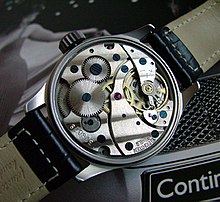
A mechanical watch is a watch that uses a clockwork mechanism to measure the passage of time, as opposed to quartz watches which function using the vibration modes of a piezoelectric quartz tuning fork, or radio watches, which are quartz watches synchronized to an atomic clock via radio waves. A mechanical watch is driven by a mainspring which must be wound either periodically by hand or via a self-winding mechanism. Its force is transmitted through a series of gears to power the balance wheel, a weighted wheel which oscillates back and forth at a constant rate. A device called an escapement releases the watch's wheels to move forward a small amount with each swing of the balance wheel, moving the watch's hands forward at a constant rate. The escapement is what makes the 'ticking' sound which is heard in an operating mechanical watch. Mechanical watches evolved in Europe in the 17th century from spring powered clocks, which appeared in the 15th century.
Mechanical watches are typically not as accurate as quartz watches,[1][2][3] and they eventually require periodic cleaning, lubrication and calibration by a skilled watchmaker.[3] Since the 1970s and 1980s, as a result of the quartz crisis, quartz watches have taken over most of the watch market, and mechanical watches (especially Swiss-made watches) are now mostly marketed as luxury goods, purchased for their aesthetic and luxury values, for appreciation of their fine craftsmanship,[2] or as a status symbol.[2]
- ^ Hahn, Ed; et al. (The TimeZone Community) (2003-10-04). "Question 1.5: Why should I get a mechanical watch when a quartz watch is so much cheaper and more accurate?". Mechanical Watch FAQ V1.0. TimeZone.com. Retrieved 2017-02-20.
- ^ a b c Lynch, Annette; Strauss, Mitchell (2007). Changing Fashion: A Critical Introduction to Trend Analysis and Cultural Meaning. Berg. pp. 148–149. ISBN 978-1845203900.
- ^ a b Haines, Reyne (2010). Vintage Wristwatches. Krause Publications. p. 9. ISBN 978-1440214790.